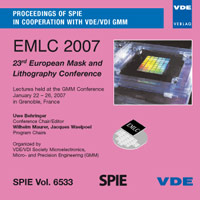Focused Electron Beam Induced Deposition of DUV transparent SiO2
Konferenz: EMLC 2007 - 23rd European Mask and Lithography Conference
22.01.2007 - 26.01.2007 in Grenoble, France
Tagungsband: EMLC 2007
Seiten: 9Sprache: EnglischTyp: PDF
Persönliche VDE-Mitglieder erhalten auf diesen Artikel 10% Rabatt
Autoren:
Perentes, Alexandre; Hoffmann, Patrik (Ecole Polytechnique Fédérale de Lausanne (EPFL), Advanced Photonics Laboratory, CH – 1015 Lausanne)
Munnik, Frans (Forschungszentrum Dresden, DE – 01314 Dresden)
Inhalt:
Focused electron beam induced processing (FEBID) equipments are the "all in one" tools for high resolution investigation, and modification of nano-devices. Focused electron beam induced deposition from a gaseous precursor usually results in a nano-composite sub-structured material, in which the interesting material is embedded in an amorphous carbonaceous matrix. Using the Hydrogen free tetraisocyanatosilane Si(NCO)4 molecule as Si source, we show how a controlled oxygen flux, simultaneously injected with the precursor vapors, causes contaminants to vanish from the FEB deposits obtained and leads to the deposition of pure SiO2. The chemical composition of the FEBID material could be controlled from SiC2NO3 to SiO2, the latter containing undetectable foreign element contamination. The [O2] / [TICS] ratio needed to obtain SiO2 in our FEB deposition equipment is larger than 300. The evolution of the FEBID material chemical composition is presented as function of the [O2] / [TICS] molecular flux ratios. A hypothetical decomposition pathway of this silane under these conditions is discussed based on the different species formed under electron bombardment of TICS. Transmission electron microscopy investigations demonstrated that the deposited oxide is smooth (roughness sub 2nm) and amorphous. Infrared spectroscopy confirmed the low concentration of hydroxyl groups. The Hydrogen content of the deposited oxide, measured by elastic recoil detection analysis, is as low as 1 at %. 193nm wavelength AIMS investigations of 125nm thick SiO2 pads (obtained with [O2] / [TICS] = 325) showed an undetectable light absorption.


